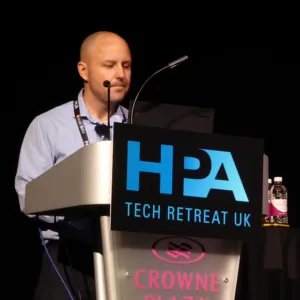Brian Hawkins, also from RealD, is the inventor of the TrueImage software. First used during post-production of ‘The Hobbit: The Desolation of Smaug’, this software is designed to eliminate artefacts.
Filmmakers can use high frame rate (HFR) to more accurately replicate the motion perception of the human visual system, said Hawkins. It also leads to improved spatial resolution and sharper images.
However, we are at the very start of HFR, and the technology still has issues. One of these is noisier images. The more photons (light) hitting a camera’s sensor, the better the image data that will be captured; when shooting in HFR, the exposure time is much lower. This means that fewer photons reach the sensor and leads to noisier images.
There are a few ways to solve the above issue: increase the camera’s ISO (increases signal’s gain to amplify signal, but also raises noise); 360° shutter angle; and image enhancement through temporal-spatial analysis and correction. The latter is RealD’s TrueImage approach.
TrueImage is intended to provide the highest-quality output image, regardless of processing time. It dynamically analyses content, so that there is no need for human intervention. The results are based on data present in the content. A clip was shown that had been smoothed by TrueImage. The clip contained a piece of locked grain, which had probably been missed by the original editor. TrueImage noted that this section of the image did not change and thus assumed that it was meant to be there. Although this is a weakness of the software, it did show that TrueImage doesn’t simply smooth the entire image.
The camera supplies three points of data per pixel (red, green and blue). After TrueImage is done, there are more than 150,000 points per pixel! All of this data takes a long time to process. There are 3×10-to-the-power-of-10 data points to handle per 2k image. This leads to an inherent conflict between the non-realtime processing and the tight deadlines of cinema. The answer was found in cloud computing, which allows TrueImage to offload processing to a number of different computers and run at near-realtime.

